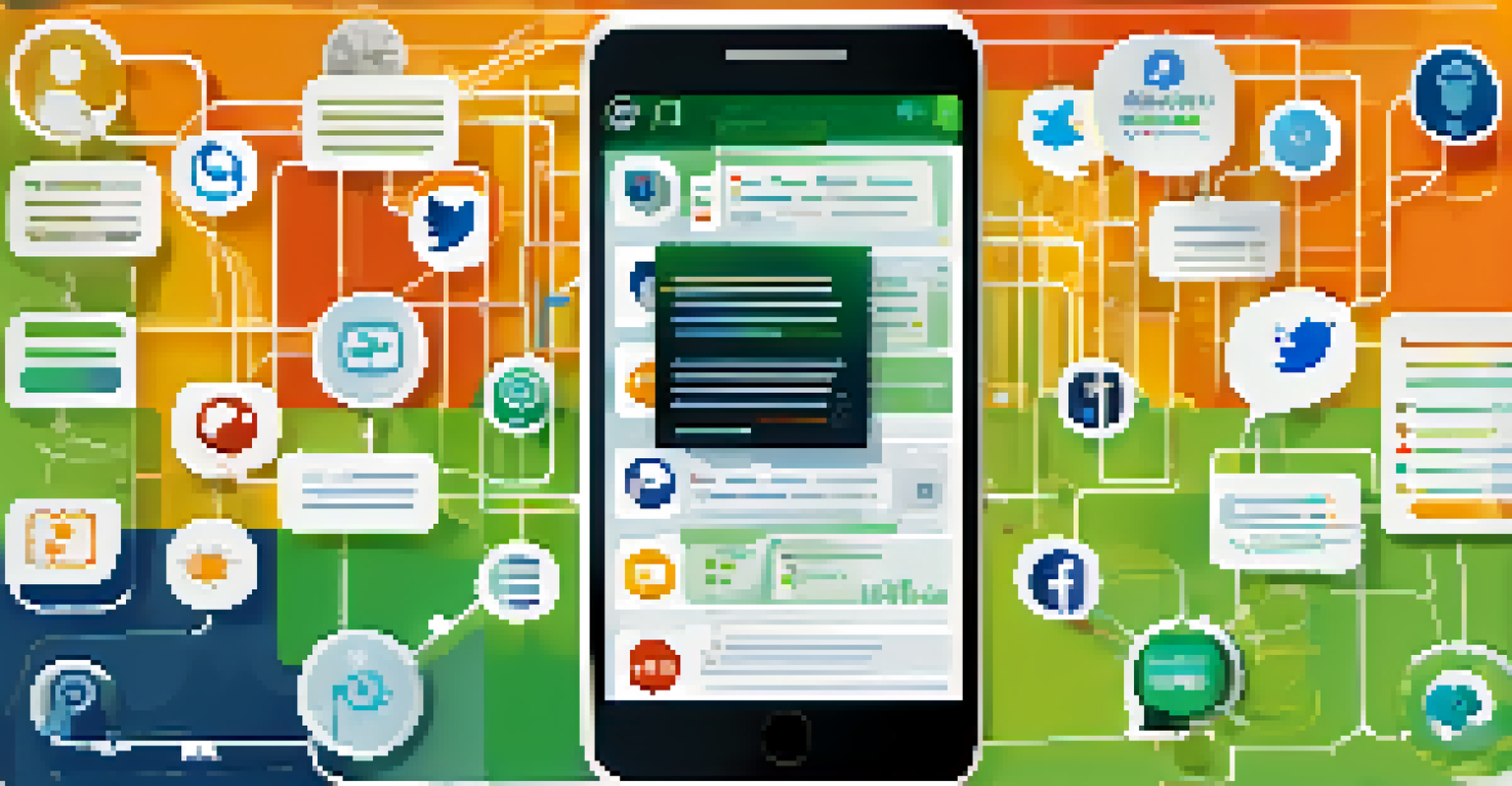Integrating Chatbots with Social Media Platforms Seamlessly

Understanding the Role of Chatbots in Social Media
Chatbots have transformed the way businesses interact with customers on social media. They serve as virtual assistants, providing immediate responses and support, which enhances user engagement. With the growing demand for instant communication, chatbots help companies meet customer expectations efficiently.
Chatbots are the new front line of customer service, providing instant communication and support.
By automating responses to frequently asked questions, chatbots free up human agents to handle more complex issues. This not only improves response times but also ensures that customers feel heard and valued. It's like having a helpful friend who’s always available to lend a hand, even in the busy world of social media.
As social media continues to evolve, the integration of chatbots becomes increasingly vital. Businesses that leverage this technology can create a more personalized experience for their customers, fostering loyalty and trust over time.
Choosing the Right Social Media Platforms for Integration
Not all social media platforms are created equal when it comes to chatbot integration. It's crucial to identify where your target audience spends their time, whether it's Facebook, Instagram, Twitter, or others. Each platform has unique features and user behaviors that can influence the effectiveness of your chatbot.

For instance, Facebook Messenger is a popular choice due to its vast user base and robust API support for chatbots. On the other hand, Instagram’s direct messaging allows brands to communicate visually, which can enhance engagement. Choosing the right platform is like picking the best stage for your performance; it can make all the difference in reaching your audience.
Chatbots Enhance Customer Engagement
By providing immediate responses, chatbots improve user engagement and allow businesses to meet customer expectations effectively.
Ultimately, selecting the right platform comes down to understanding your customers' preferences and behaviors. This ensures that your chatbot is not only integrated seamlessly but also delivers value where it counts.
Designing an Engaging Chatbot Experience
Creating an engaging chatbot experience requires a thoughtful approach to design and functionality. Start by defining the purpose of your chatbot—will it answer questions, help with purchases, or provide customer support? This clarity will guide your design process.
The best chatbots are not just programmed to respond; they learn from users and adapt to their needs.
Next, consider the personality of your chatbot. Should it be formal, friendly, or cheeky? Just like a well-written character in a book, your chatbot’s personality should resonate with your brand’s voice and values. It’s important to create a chatbot that feels relatable, making users more likely to engage.
Lastly, incorporate visual elements and interactive features to enhance the user experience. Think of it as adding sprinkles on a cake—these elements can make the interaction more enjoyable and memorable for users.
Integrating Chatbots with Existing Systems
To maximize the effectiveness of your chatbot, it’s essential to integrate it with your existing systems. This includes customer relationship management (CRM) software, inventory management, and other tools that your business already uses. Seamless integration ensures that your chatbot has access to up-to-date information, allowing for more accurate responses.
For example, if a customer asks about a product's availability, a well-integrated chatbot can pull real-time data from your inventory system. This not only saves time but also enhances customer satisfaction by providing accurate information instantly. Think of it as giving your chatbot a well-stocked toolbox; it can do its job much more efficiently.
Choose the Right Platform
Identifying the social media platforms where your audience is active ensures that your chatbot delivers the most value.
Moreover, integrating chatbots with analytics tools can help you track performance and user interactions, allowing for continuous improvement. By analyzing data, you can refine your chatbot’s responses and enhance its capabilities over time.
Testing and Optimizing Your Chatbot
Once your chatbot is integrated, testing is crucial to ensure it works as intended. Start by conducting various scenarios to see how the chatbot responds to different user inputs. This step helps identify any gaps in knowledge or functionality that may need addressing before launching.
After testing, the optimization process begins. Collect feedback from users and monitor interactions to understand where improvements can be made. It's akin to refining a recipe—tweaking ingredients can lead to a more delightful dish.
Regular updates and maintenance are essential to keep the chatbot relevant and effective. As customer needs evolve, so should your chatbot, ensuring it remains a valuable asset for your social media strategy.
Leveraging User Feedback for Improvement
User feedback is a goldmine for enhancing your chatbot’s performance. Encourage users to share their experiences and suggestions after interactions. This not only provides valuable insights but also fosters a sense of community around your brand.
Consider implementing a rating system or a quick survey after conversations. Just like a restaurant might ask for a review after a meal, this feedback loop can help you understand what’s working and what’s not. It’s all about listening to your audience and making adjustments accordingly.
Continuous Improvement is Key
Leveraging user feedback and monitoring performance are essential for optimizing your chatbot and maintaining its relevance.
Incorporating user feedback into your chatbot development is an ongoing process. By actively engaging with users and refining your chatbot based on their input, you create a better experience that aligns with their expectations.
Measuring Success and ROI of Chatbot Integration
To determine the effectiveness of your chatbot integration, it's crucial to measure success through key performance indicators (KPIs). These may include metrics such as response time, user satisfaction, and engagement rates. Think of these metrics as the scorecard for your chatbot’s performance.
Additionally, assessing the return on investment (ROI) is essential. Compare the costs of implementing the chatbot against the benefits it brings, such as reduced customer service costs and increased sales conversions. This analysis helps justify the investment and guides future decisions.

Ultimately, tracking these metrics allows you to make data-driven decisions, ensuring that your chatbot continues to evolve and deliver value to your business and customers.